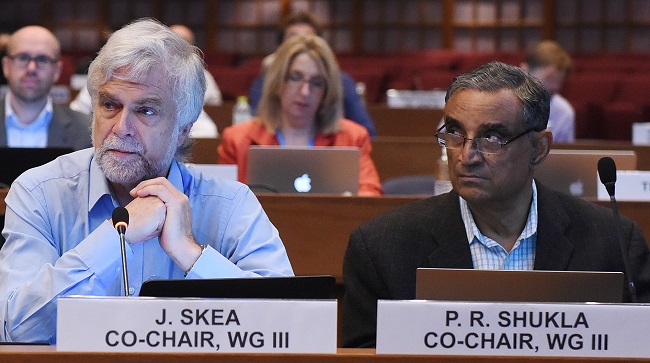A new report by the Intergovernmental Panel on Climate Change (IPCC) released on April 4, 2022, shows that accelerated international cooperation on finance to support low-income countries is a critical enabler of a low-carbon and just transition.

The Working Group III report, titled “Climate Change 2022: Mitigation of Climate Change,” points out that scaled-up public grants for adaptation and mitigation and funding for low-income and vulnerable regions, especially in sub-Saharan Africa, may have the highest returns.
According to Celine Guivarch, one of the lead authors, the report shows that reducing emissions at the speed and scale required to limit warming to two degrees or below implies deep economic changes that could increase inequality between and within countries.
“But policies can be designed to avoid increasing or even decrease economic inequality and poverty. This entails broadening access to clean technologies and international finance. In applying just transition principles to integrate considerations of equity and justice into policies at all scales and enable accelerated mitigation action,” said Guivarch.
Key options according to the report include: Increased public finance flows from developed to developing countries beyond $100 billion-a-year; shifting from a direct lending modality towards public guarantees to reduce risks and greatly leverage private flows at lower cost; local capital markets development; and, changing the enabling operational definitions.
According to Brett Cohen, one of the coordinating lead authors, the report recognises that mitigation must be region and context specific. So not all actions are applicable everywhere. Furthermore, it highlights the multiple sustainable development benefits from mitigation, as well as the trade-offs that need to be considered. Understanding and accounting for these will help to build the support base for mitigation action.
He further noted that the report considers mitigation from a system point of view so as to maximise various interactions to optimise benefits. For instance, if we are to change to clean cooking at household level, it is best if this is achieved through renewable energy. Further, mitigation efforts need to look at how various sectors and agendas such as the sustainable development goals complement each other.
On the role of Africa in mitigation, Cohen believes that it is more important to ensure low emissions development trajectories, to ensure that development leapfrogs the high emissions historically found in developed countries. The report explores the concept of sustainable development pathways, demonstrating that all decisions taken along the development trajectory have implications for the emissions intensity for economies.
The authors also found that agriculture, forestry, and other land use can provide large-scale emissions reductions and also remove and store carbon dioxide at scale.
“Agriculture, forestry, and other land use contribute 22% of global emissions,” said Mercedes Bustamante the lead author: Forest conservation, nature-based solutions, options for developing countries.
This sector, according to Bustamante, can not only provide large-scale reductions of emissions but can also remove and store CO2 at scale.
She observed that the knowledge and experience of Indigenous Peoples and local communities are crucial for land-based mitigation. That mainstreaming these insights relies on governance that emphasises integrated land use planning and management framed by Sustainable Development Goals.
“Well-designed land-based mitigation options to remove carbon can also benefit biodiversity and ecosystems, help us adapt to climate change, secure livelihoods, improve food and water security. Options include protecting and restoring natural ecosystems such as forests, peatlands, wetlands, savannas, and grasslands,” said the author.
Laura Diaz Anadon, another lead author who focused on Policies & Renewable Energy, said that evidence reviewed in the report showed that while a lot of the decarbonisation policies that have been put in place around the world have had a positive impact on innovation, technology, deployment and environmental outcomes.
“In some cases, they have also had a short-term negative impact on vulnerable groups, low-income groups, and in some cases that they have favored, for example, large firms over small firms. We have also found that this is something that can be avoided by designing policies in a different way or putting in place complementary policies,” said Anadon.
According to Nokuthula Dube, the IPCC Lead Author, Chapter 15 on Investment and Finance, the report highlights the importance of mobilising diverse sources of capital from both local and international sources in tackling climate change and sustainable development.
“Our assessment points to accelerated international co-operation on finance as a critical enabler of a low carbon and just transition. Scaled-up public grants in the funding to tackle climate change for low-income and vulnerable regions, especially in Sub-Saharan Africa, may have the highest returns.
“Meeting the $100 billion UNFCCC Copenhagen Accord on a grant-equivalent basis could support Paris aligned NDCs (national plans) integrate policies on COVID-19 pandemic recovery, climate action, sustainable development, just transition and equity in the process harnessing co-benefits towards hidden energy poverty such as clean-cooking. Close to three billion people in Africa and developing Asia have no access to clean cooking energy,” Dube stated.
The report is the Working Group III contribution to the IPCC’s Sixth Assessment Cycle (AR6), and examines current trends of emissions, projected levels of future warming, and how to transition to a low carbon economy in order to limit global warming to 1.5°C by 2100, in line with Paris targets.
It considers trends in sectoral emissions across energy, transport, agriculture, buildings and industry, and projected warming levels based on current levels of policy commitment. The report shows how transformative systems can ensure a safer climate and a sustainable economy.
